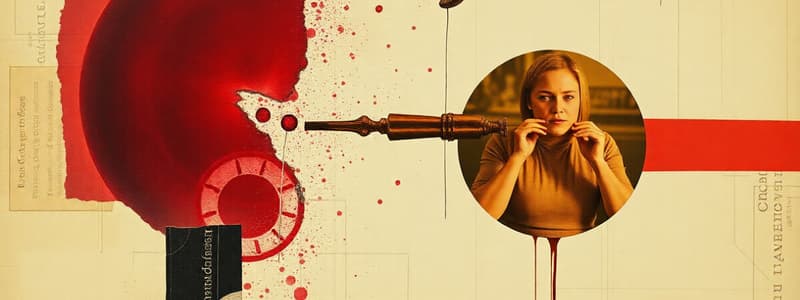Podcast
Questions and Answers
What is the primary site of red blood cell formation?
What is the primary site of red blood cell formation?
- Liver
- Spleen
- Intestines
- Bone Marrow (correct)
How long do mature red blood cells typically circulate in the bloodstream?
How long do mature red blood cells typically circulate in the bloodstream?
- 120 days (correct)
- 90 days
- 30 days
- 60 days
Which organs are primarily involved in the breakdown of aged or damaged red blood cells?
Which organs are primarily involved in the breakdown of aged or damaged red blood cells?
- Bone Marrow, Pancreas, Spleen
- Kidneys, Lungs, Intestines
- Spleen, Liver, Macrophages (correct)
- Heart, Lungs, Brain
What does hemoglobin break down into during red blood cell recycling?
What does hemoglobin break down into during red blood cell recycling?
What is the fate of iron ($Fe^{2+}$) after the breakdown of heme?
What is the fate of iron ($Fe^{2+}$) after the breakdown of heme?
What happens to bilirubin processed by the liver?
What happens to bilirubin processed by the liver?
In which part of the body is bilirubin converted to urobilinogens and stercobilins?
In which part of the body is bilirubin converted to urobilinogens and stercobilins?
What are stercobilins responsible for?
What are stercobilins responsible for?
How is urobilinogen processed after its formation in the intestines?
How is urobilinogen processed after its formation in the intestines?
What role do macrophages play in the red blood cell recycling process?
What role do macrophages play in the red blood cell recycling process?
Flashcards
Where are RBCs formed?
Where are RBCs formed?
Red blood cells (RBCs) are formed in the bone marrow.
What is the lifespan of an RBC?
What is the lifespan of an RBC?
RBCs circulate in the blood for about 120 days, delivering oxygen to the body's tissues.
Where are old RBCs broken down?
Where are old RBCs broken down?
Old or damaged RBCs are broken down by macrophages in the spleen, liver, and bone marrow.
What happens to hemoglobin when RBCs are broken down?
What happens to hemoglobin when RBCs are broken down?
Signup and view all the flashcards
What happens to heme after it's broken down?
What happens to heme after it's broken down?
Signup and view all the flashcards
What happens to bilirubin in the liver?
What happens to bilirubin in the liver?
Signup and view all the flashcards
Where does bilirubin go after the liver?
Where does bilirubin go after the liver?
Signup and view all the flashcards
What happens to bilirubin in the intestines?
What happens to bilirubin in the intestines?
Signup and view all the flashcards
How does the body eliminate bilirubin byproducts?
How does the body eliminate bilirubin byproducts?
Signup and view all the flashcards
What is the overall process of RBC breakdown and recycling?
What is the overall process of RBC breakdown and recycling?
Signup and view all the flashcards
Study Notes
Red Blood Cell (RBC) Breakdown
- RBCs have a lifespan of 120 days
- 90% of RBCs are broken down by macrophages in the spleen and liver
- 10% undergo hemolysis
- Old and damaged RBCs are removed from circulation
- Hemoglobin (Hb) is broken down into heme and globin
- Heme is further broken down into iron (Fe2+) and bilirubin
- Iron is recycled and transported in the blood by transferrin
- Bilirubin is transported to the liver
- Bilirubin is processed by the liver and converted to bile
- Bile is released into the small intestine
- Bilirubin is further processed into urobilin and stercobilin
- Urobilin is excreted in the urine
- Stercobilin is excreted in the feces
- New RBCs are produced in bone marrow
- New RBCs are released into circulation
Bilirubin Metabolism
- Bilirubin is a byproduct of heme breakdown
- Bilirubin is transported to the liver
- The liver processes bilirubin and converts it to bile
- Bile is released into the small intestine
- Bilirubin is further processed into urobilin and stercobilin
- Urobilin is excreted in urine
- Stercobilin is excreted in feces
Iron Metabolism
- Iron (Fe2+) is released from heme during RBC breakdown
- Iron is transported in the blood by transferrin
- Iron is stored and recycled for new RBC production
Kidney Function in RBC Breakdown
- Bilirubin-derived products are eliminated by the kidneys in the urine.
Studying That Suits You
Use AI to generate personalized quizzes and flashcards to suit your learning preferences.




